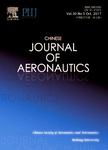Numerical Investigation of Aluminum Foam Shield Based on Fractal Theory and Node-separation FEM
Numerical Investigation of Aluminum Foam Shield Based on Fractal Theory and Node-separation FEM作者机构:School of Astronautics Beihang University Beijing 100191 China
出 版 物:《Chinese Journal of Aeronautics》 (中国航空学报(英文版))
年 卷 期:2011年第24卷第6期
页 面:734-740页
核心收录:
学科分类:07[理学] 08[工学] 070104[理学-应用数学] 0815[工学-水利工程] 0805[工学-材料科学与工程(可授工学、理学学位)] 081503[工学-水工结构工程] 0701[理学-数学]
主 题:aluminum foam simulation fractal hypervelocity impact FEM
摘 要:Fractal feature of aluminum foam (Al-foam) section is analyzed with digital image processing technique, and fractal dimension of Al-foam is evaluated with logarithmic linear regression method. Sierpinski carpet can be used to model Al-foam section. Al-foam with different fractal dimensions and relative density can be obtained by adjusting iteration times and division parameters. Sierpinski sponge is extended from Sierpinski carpet and used to model 3D Al-foam bumper. Node-separation Lagrangian finite element method (FEM) is introduced to simulate the hypervelocity impact (HVI) process. The modeling and simulation method is calibrated by the comparison of numerical results and experimental data. Ballistic limit curves of Al-foam and aluminum alloy bumper with the same areal density are obtained by simulations. The results show that the protection pertbrmance of Al-foam bumner is much better than aluminum alloy bumper. Al-foam is well suited for spacecraft shield application.



